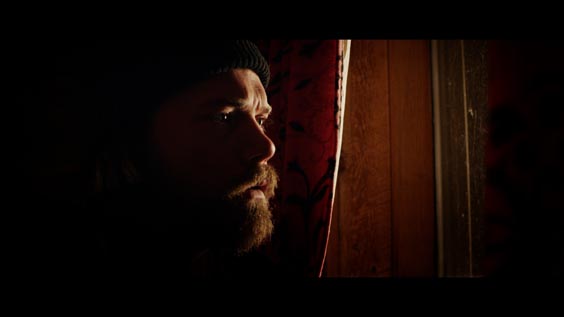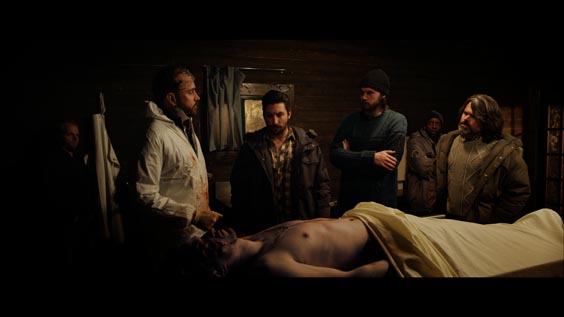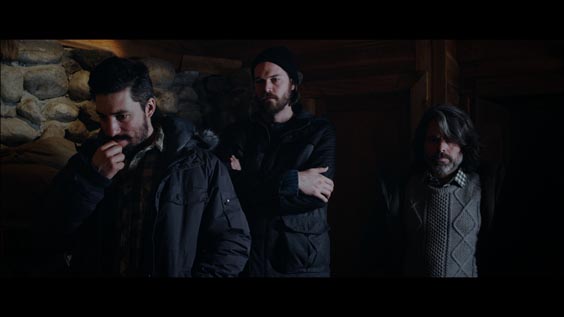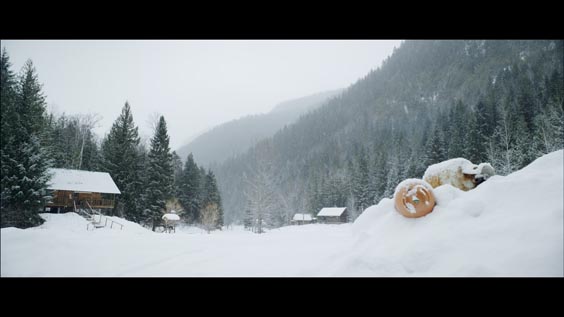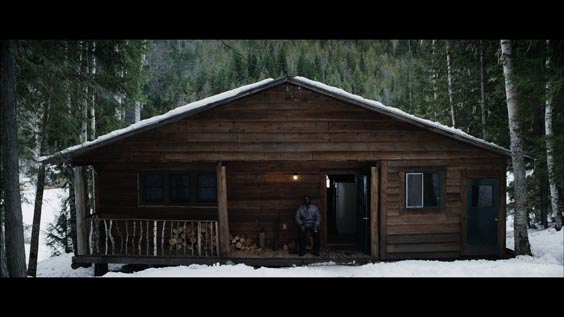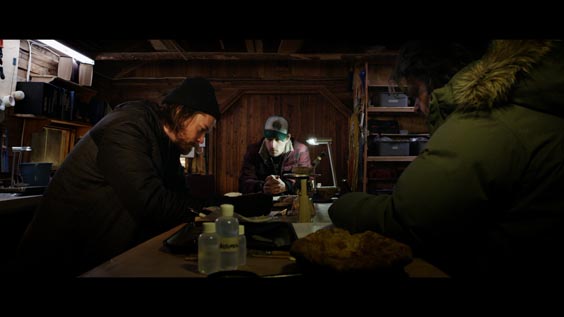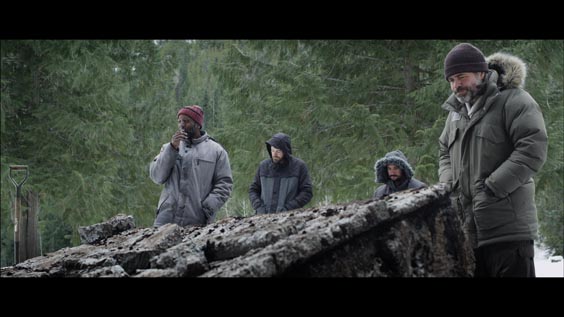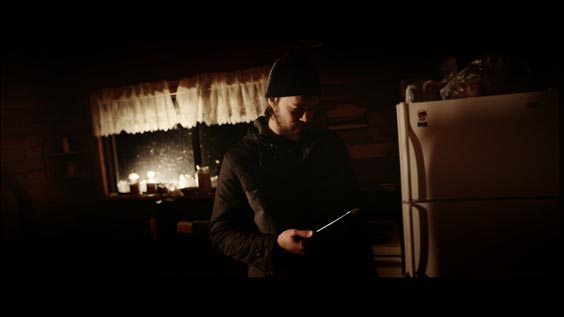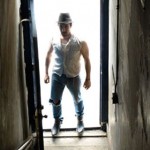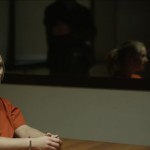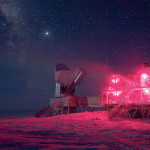FROZEN TERROR: ‘BLACK MOUNTAIN SIDE’
With its vast expanses of uninhabited land, Canada’s frozen north is relatively unexplored cinematic turf in terms of its genre potential. The popular subgenre of snowbound horror – often specifically located at a remote scientific outpost, as in TV movie A Cold Night’s Death (1973) John Carpenter’s The Thing (1981) or Larry Fessenden’s The Last Winter (2006) – emphasizes the natural terror of isolation and disconnection from normalized modes of ‘civilization’. The blinding whiteness of the snow, and the silence that snow brings with it, seems to invite a paralyzing terror of the imagination – like a blank canvas for our fears to be projected on. It sounds cliché, but many filmmakers have tapped the tundra for this very quality; it’s a characteristic of nature-based horror films in general (from Aussie fave Long Weekend (1978) to Swedish TV sensation Twelve Months of Summer (1988)), adapted somewhat from the Romantic tradition of literature and visual arts, but especially potent when that landscape is frozen cold.
With a handful of Vancouver-based actors – including frequent Larry Kent collaborators Shane Twerdun and Andrew Moxham – director Nick Szostakiwskyj’s sophomore feature is a masterful exercise in mounting suspense, carried off by both cinematographer Cameron Tremblay’s gorgeous, snowy tableaux and this tight ensemble of emerging thesps who bring his increasingly paranoid characters to life.
I saw the film at the 2014 Blood in the Snow Film Festival (a weekend event in Toronto focused on showcasing new Canadian genre films), where it picked up the award for best cinematography, and immediately went after it for SF Indie, where it has its Bay Area premiere this Saturday at the Roxie. On the eve of the SF Indie screening, I spoke to director Nick Szostakiwskyj about his cinematic inspirations, the trickery of locations, and the film’s interface between science and existentialism.
BUY TICKETS TO THE SF INDIE SCREENING HERE.
KJ: One of the obvious reference points everyone makes when writing about the film is John Carpenter’s remake of The Thing. Was this the straight-up inspiration for the film or were there other factors at work in developing the tone of the film?
NS: While The Thing is certainly one of my favourite horror movies, it actually wasn’t the main inspiration for the film. The two biggest inspirations were The Shining (1980) and The Andromeda Strain (1971). Other movies I drew inspiration from include The Fly (1986), Altered States (1980) and Alien (1979).
My favourite aspects of Carpenter’s The Thing are the setting and the characters–and I think that shows in Black Mountain Side. I admire The Thing’s grit and the almost “hyper-masculine” approach. None of the characters are caught making-out or smoking a doobie. They don’t die while running, crying and screaming, while tripping and falling on the ground. They face their crisis head on. These aren’t men struggling with their emotions. These are men getting the job done. No other movies that I know about really have that quality.
The Shining was the biggest tonal inspiration. Kubrick was the undisputed champion of tone and atmosphere. His pacing is unmatched. Films like Full Metal Jacket, The Shining and Eyes Wide Shut are perfect examples of how pacing can create unprecedented tone. He spends lots of time with character development, which I absolutely adore. (The biggest problem with modern horror is the pace–terrible character development and too much emphasis on being “scary”, but I digress)
Kubrick is always telling the real story behind closed doors. There always a much more complex narrative happening, and he only ever offers glimpses into the reality of his films. Eyes Wide Shut is a perfect example–There’s only one scene in the middle of the film where we see this mysterious hidden world. But when we aren’t in that crazy world, we still see the consequences of actions unseen.
I watched The Andromeda Strain when I was nine or ten years old, late at night while surfing through channels. I came upon it completely by accident, and was strangely mesmerized by how boring it was. It was so slow moving and smart–it really forced you to listen as it slowly set up a very complex ideology. It posed many questions and didn’t spoon-feed the answers to the audience. As a child, I had absolutely no idea what was going on, but I really admired it. When I watched it again as an adult, I was able to appreciate it in a whole new light. The cinematography is completely unique and the setting is haunting. It’s worth checking out if you haven’t seen it.
KJ: Tell me about the casting. It’s a really unique group of characters you’ve put together, and the ensemble cast really works. Some of the actors – like Shane Twerdun – come from a strong improvisational background, how much was this utilized in the film?
NS: The casting process was easy–I was lucky to know some very talented actors before writing the script, and I was able to tailor the characters to their strengths. Actors like Shane Twerdun, Andrew Moxham, Steve Bradley and Tim Lyle were cast in my mind before the first draft of the script was finished, as I’d worked with them many times before.
I was working a crappy TA job at the Vancouver Film School while I was writing the script. Part of my job was to film the acting department improv exercises. I worked there for eight class intakes. Each intake shot thirty little improv movies. I filmed A LOT of those improv movies. Very few of the students that went through the program took it seriously–most of them were more interested in partying and “being famous”. I was caught off guard one day when one particularly tall Swedish man went to do his improv and was absolutely spectacular. I stopped thinking about the camera I was supposed to operate, and just started to watch his performance. I went online that afternoon and found a picture of him and attached it to the Black Mountain Side screenplay. That man was Carl Toftfelt. I tracked him down and practically begged for him to be Monroe. Thankfully, he really liked the role.
Marc Williams and Michael Dickson were found through a traditional casting call. I can still remember both of their standout auditions.
As for improv, there was almost no improv in the film. The very first scene was all improvised–admittedly clumsily on my part. I’ve always considered myself a writer first are foremost, so I’m not a very big fan of improv.
Fun fact, I was the boom operator on Twerdun’s Two Married People (directed by Andrew Moxham), with our sound mixer, Adam Pisani (my good friend, and former roommate). It was the first time we’d ever seen Shane act, and we were both very impressed. I think that Twerdun is a true master of understated emotion.
KJ: Tell me about the shooting conditions? How far north were you, how cold was it, and how long were you there? Were there any mishaps specifically related to the temperature?
NS: This question comes up a lot, and the answer always surprises people. It wasn’t that cold. I don’t think it ever dipped below -8*C (Where I’m from in Calgary, that’s a late-summer night). We were actually fighting the melting snow. You can actually see the snow melting off of rooftops in certain scenes. The biggest challenge was remembering to act cold! It’s easy to forget when you are anything but. We had no mishaps or technical difficulties due to the cold.
The biggest struggle was our isolation. We really were isolated up in those mountains. We were a thirty minute drive from cell reception, and there was no internet in any of the cabins. Trying to produce a film, while also directing was really difficult without internet or cell service. After 14 hours of shooting, Cameron Tremblay and I would have an hour-long meeting, then we would drive thirty minutes down the mountain and make calls. There were nights that I didn’t sleep, and I don’t think I ever slept for more than 3 hours on any given night.
KJ: Also, on the nerdy side of things, does the camp actually exist as a site people can visit?
NS: Yes! And it is actually a very lovely place. It’s called Cozy Cabins, and it’s near a little town called Lumby. It’s easy to find on Google. I definitely recommend visiting. I plan on going for a few days, maybe this summer. It’s about 4.5 hours from Vancouver. The family that runs the resort is incredibly kind and accommodating.
KJ: One of the most mixed responses I’ve heard about the film is in regards to the level of exposition at the end, in the last five minutes or so. Without releasing spoilers can you talk about what led to this choice, when so much of the rest of the film is so enigmatic?
NS: Hmm… I think “exposition” is maybe a weird word choice, but I understand the sentiment. I think exposition is an almost ironic word, as the ending generally raises more questions than it answers with audiences, which is the opposite of expository. That being said, there is a heavy monologue near the end which contains lots of information concerning the themes and the plot.
From the conceptual stages, my goal was to create a puzzle–much like Kubrick did with his films. I wanted to make Black Mountain Side a sort of existential mystery. (I’m about to get really philosophical on you here)–The big question: The meaning of life. That’s the question Black Mountain Side ambitiously attempts to face. It’s a question I think everyone thinks about. It’s such a BIG question, and no one is ever really sure of the answer. But, if you ever walk outside of the city–away from everything and just look around, you get this weird feeling that the answer is right in front of you. Our set-carpenter, Jeff Coates told me that fishing in Northern Canada, way out in the wilderness, was the closest he ever came to a “religious experience”. I think a lot of people have similar experiences.
I wanted to try to capture that feeling in Black Mountain Side, where you can feel the answer is right there–like you are so close to it, but it still alludes you. The ending of the film is the beginning of the puzzle–the first clue in the scavenger hunt, if you will. After, you need to go back and watch for the next clues.
KJ: What was the funding process for the film? Do you feel there is more support for genre efforts in Canada these days, or did you have to play down the genre elements to get funding?
NS: Our executive producer, Samantha McDonald was the driving force behind the film’s fundraising, and she could probably offer a more articulated response. We went the private investment route, avoiding the route-more-travelled that is Telefilm (here in Canada). It was important to us to hold onto our creative integrity, and to find likeminded investors who saw what we saw in the film.
We really played up the genre element, if anything. Our investors like genre movies! Also, genre movies make money–especially relative on the indie scale. When you don’t have Tom Cruise or Christian Bale, you need a hook. Our hook was that we were making a 70s-style horror film, which I truly believe there is a high demand for.
KJ: Was there anything specific that informed the science of the picture and the ancient civilization that left this structure behind?
NS: Before I dropped out of university, I was working towards a minor in archaeology. I’ve always been really interested in ancient civilizations. There is this sort of gap in human history–how humans came to be in the Americas. There are lots of theories, but they’re always finding new evidence that changes everything.
When you are dealing with a science fiction film (which Black Mountain Side is, to an extent), it’s important to be really versed in the science of the narrative. I can’t stand it when a movie just makes a bunch of stuff up and expects you to suspend disbelief–it becomes an easy plot device out of sticky situations. I wanted Black Mountain Side to have an air of integrity about it. I did a lot of additional research into the ice-free-corridor theory (the theory that suggests humans moved through an ice-free-corridor during the ice-age into the Americas from Asia). I gave Toftfelt my old archaeology textbooks and he did a lot of his own research. Together, we worked on his lines to be more realistic.
Also, we reached out to archaeologist, Teresa B. Wagner M.A. She went through our script and made some very insightful notes, which we very carefully incorporated into the dialogue, and art.
The structure in the film is supposed to throw all of the standard theories out of the window. To me, it represents the destruction of everything we thought we knew. It says “you don’t know anything“. I think that’s an important message, especially in the 21st century. I think we, as individuals and as a society, lean too hard on what we’re told–what we think we know. One hundred and ten years ago, people thought that physics was a fad on its way out, and then Einstein gave us Relativity. We thought that flight was impossible–science-fiction, and then The Wright Brothers proved that wrong. These days, we accept everything. One hundred and ten years is nothing relative to human history. Things will change again, but we need to open our minds first. When I was in high school, my teacher taught the ice-free-corridor theory as if it was an absolute fact. It wasn’t until University that I learned it was a theory that wasn’t even totally accepted.
Monroe (Toftfelt) in the film is sure about the ice-free-corridor theory, but he naively overlooks certain qualities of the structure that dispute the theory. Olsen (Dickson) is the only one willing to open his mind and search for clarity.
KJ: The aboriginal component of the film was interesting too, because the politics surrounding established aboriginal communities in northern Canada is something that doesn’t get addressed in our genre films nearly enough – even though they make the choice to exit the picture pretty early on. Can you talk about the context for these characters and the role you wanted to create for them in the film?
NS: Interesting question. Admittedly, when I wrote the first draft, the aboriginals were there as a device to move the plot from A to B. They were a bit stereotypical, and the film started to feel cliche. (Originally, they barely spoke English) I took a step back and thought about it, and how I could tie them into the theme, and avoid being cliche (and ignorant). I started to think about the people I knew who were aboriginal and I realized that real aboriginal people are nothing like they’re ever portrayed in film. I decided to go back and treat them as if they were simply non-descript workers. The only stereotypes and ignorance come from the protagonists’ dialogue–if you look, they’re just an ordinary group of workers. In a tongue-and-cheek sort of way, I flipped the stereotype onto it’s head. When the cat dies at the start in a sort of ritualistic way, it’s the aboriginal worker who goes and tells the boss about seeing the whitest guy in the crew doing it. When asked why he did it, the worker shrugs and goes “I dunno.”
There’s no ancient burial ground, native rituals or superstitions–except from the paranoia of the protagonists. When the workers leave, the characters suggest that maybe it was a superstition, and that “they believe in all sorts of wacky shit”. In reality, that isn’t the case. That’s just the characters being narrow-minded. When asked about the aboriginals and whether they speak English, Jensen, the character who hires the workers says “They’re all fluent in English…”, touching on the idea that people have these misconceptions about aboriginals.
As for their role in the film–it’s all part of the mystery. People often ask “What happened to the aboriginals? Did they die? Where did they go?”. I don’t like giving anything away, and I think that it should be left subjective, but I have my own theory–Maybe you’ll see it in a sequel?
++++

 February 6, 2015
February 6, 2015  No Comments
No Comments
